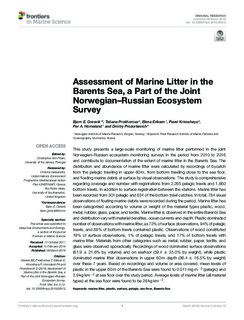| dc.description.abstract | This study presents a large-scale monitoring of marine litter performed in the joint Norwegian–Russian ecosystem monitoring surveys in the period from 2010 to 2016 and contribute to documentation of the extent of marine litter in the Barents Sea. The distribution and abundance of marine litter were calculated by recordings of bycatch from the pelagic trawling in upper 60 m, from bottom trawling close to the sea floor, and floating marine debris at surface by visual observations. The study is comprehensive regarding coverage and number with registrations from 2,265 pelagic trawls and 1,860 bottom trawls, in addition to surface registration between the stations. Marine litter has been recorded from 301 pelagic and 624 of the bottom trawl catches. In total, 784 visual observations of floating marine debris were recorded during the period. Marine litter has been categorized according to volume or weight of the material types plastic, wood, metal, rubber, glass, paper, and textile. Marine litter is observed in the entire Barents Sea and distribution vary with material densities, ocean currents and depth. Plastic dominated number of observations with marine litter, as 72% of surface observations, 94% of pelagic trawls, and 86% of bottom trawls contained plastic. Observations of wood constituted 19% of surface observations, 1% of pelagic trawls, and 17% of bottom trawls with marine litter. Materials from other categories such as metal, rubber, paper, textile, and glass were observed sporadically. Recordings of wood dominated surface observations (61.9 ± 21.6% by volume) and on seafloor (59.4 ± 35.0% by weight), while plastic dominated marine litter observations in upper 60 m depth (86.4 ± 16.5% by weight) over these 7 years. Based on recordings and volume or area covered, mean levels of plastic in the upper 60 m of the Barents Sea were found to 0.011 mg m−3 (pelagic) and 2.9 kg km−2 at sea floor over the study period. Average levels of marine litter (all material types) at the sea floor were found to be 26 kg km−2. | nb_NO |
